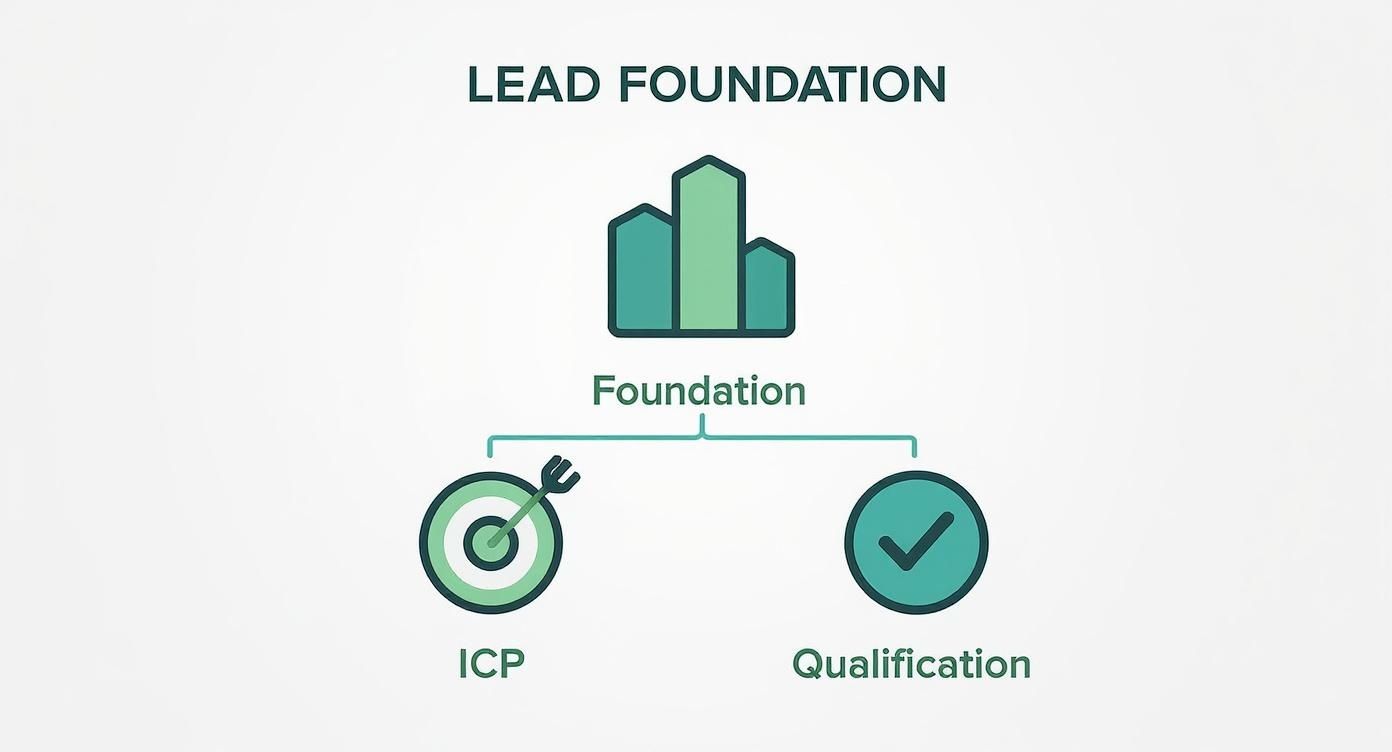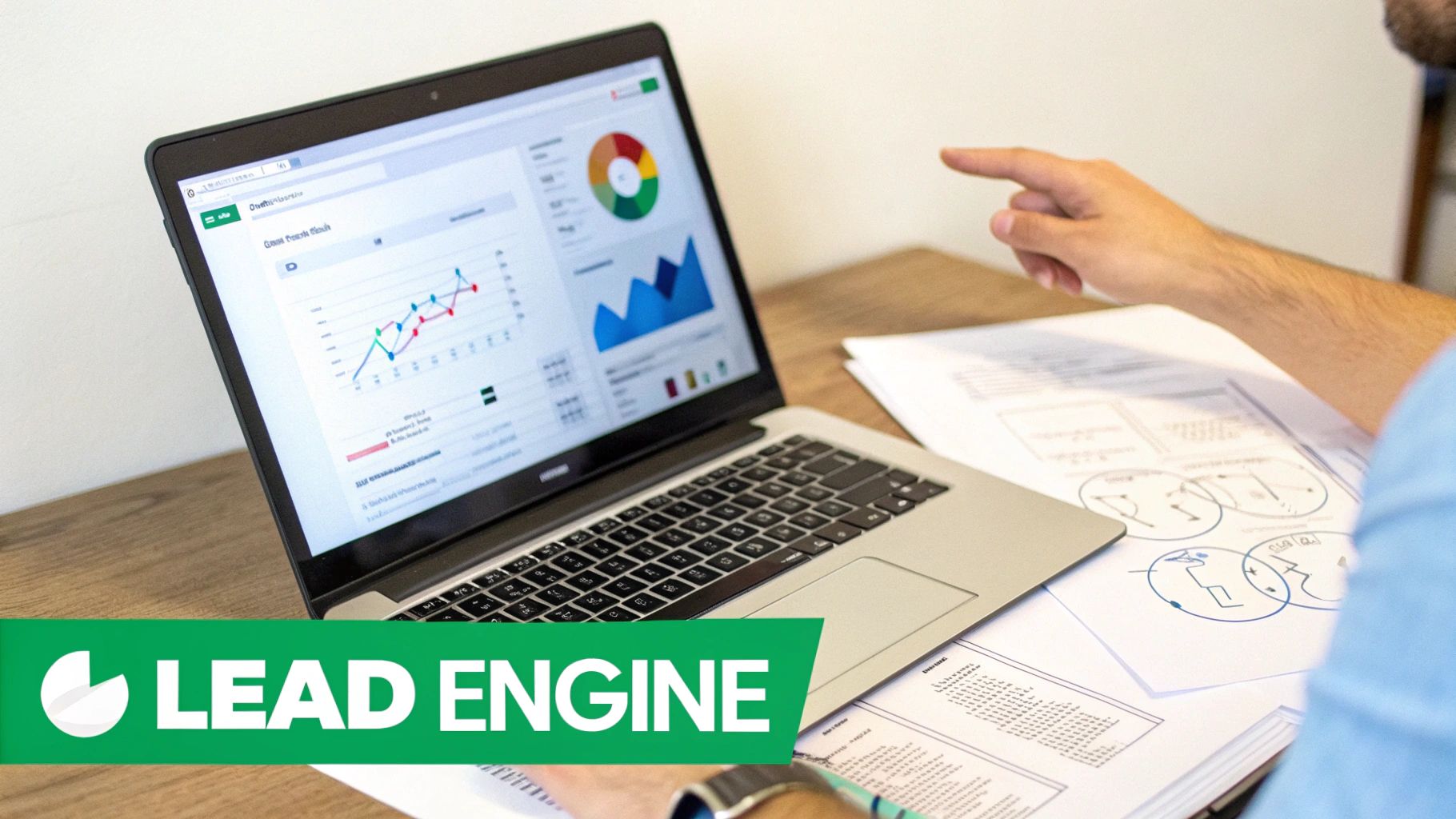How to Find Sales Leads That Actually Convert
Finding sales leads that actually convert isn’t about casting a wide net and hoping for the best. It’s a focused strategy: Define your ideal customer, get to the heart of their pain points, and then use the right channels—like social listening, SEO, and smart outreach—to connect with them. This quality-over-quantity approach ensures your team’s energy is spent on prospects who are genuinely likely to buy.
Build Your Foundation for Finding Quality Leads
Before you even think about writing an outreach email or making a call, you need absolute clarity on who you're trying to reach. Chasing every possible prospect is a fast track to burning out your sales team and wasting a ton of money. The best lead generation strategies are always built on a solid foundation, and that starts with a deep, almost obsessive, understanding of your ideal customer.
To get this right, you first need to grasp what B2B lead generation really means and the core strategies that attract the right kind of businesses. This initial step keeps you from spraying and praying.
Create a Detailed Ideal Customer Profile
An Ideal Customer Profile (ICP) is way more than just a company's size and industry. A truly powerful ICP gets into the nitty-gritty—the psychographics and operational realities of a business. Think of it as a living document that keeps your sales and marketing teams perfectly aligned, so everyone is aiming at the same high-value targets.
When building out your ICP, dig into these elements:
- Pain Points: What specific, expensive problems are they wrestling with that your solution directly fixes? Go beyond the surface-level stuff and pinpoint the root causes of their headaches.
- Buying Triggers: What events inside their company would signal an immediate need for your product? This could be a fresh round of funding, a key hire in a specific department, or even public complaints about a competitor's shoddy service.
- Operational Details: What tech are they already using? What’s their internal decision-making process really like? Knowing their current tech stack and who calls the shots helps you tailor your pitch perfectly.
For a deeper dive, our guide on how to identify a target audience offers more frameworks and tips to really sharpen your focus.
The infographic below lays out the core components of a strong lead generation foundation.

As you can see, a solid foundation rests on two pillars: a precise Ideal Customer Profile and a tough qualification process. They work together to filter out all the noise.
Qualify Leads to Avoid Wasted Effort
Once you have a crystal-clear ICP, the next move is to qualify the interest coming your way. Just because a lead fits your profile doesn't mean they're ready—or even able—to buy. Using a modern qualification framework is key to prioritizing your time where it counts.
A classic mistake is treating every form submission like a hot lead. The reality? Many are just kicking tires or looking for information. A strong qualification process separates the curious from the genuinely committed, letting your team focus on deals that have a real shot at closing.
This discipline is what stops your sales team from spinning their wheels on leads that were never going to convert anyway. It’s a massive boost for both efficiency and morale.
Turn Your Website Into a Lead Generation Engine
Your website should be more than just a digital brochure; it needs to be your hardest-working salesperson, pulling its weight 24/7. The trick is to stop thinking of it as a passive asset and start treating it like an active tool for generating sales leads. It does this by offering real value long before you ever ask for the sale.

This shift starts with content. But not just any content—it has to solve genuine problems for your ideal customers. Instead of another blog post listing your product features, think about creating a detailed guide that helps them solve a common industry headache. This is how you build trust and establish authority, making prospects far more likely to come to you when they're ready to talk business.
Create Content That Attracts High-Intent Traffic
To get visitors who are actually looking for solutions, you need a smart content strategy grounded in search engine optimization (SEO). This isn't about stuffing keywords into pages. It’s about deeply understanding the questions your audience is asking and creating the absolute best answer on the internet.
Start by digging into high-intent keywords. These are the phrases people use when they're close to making a buying decision. For instance, someone searching for "best social listening tools for startups" is a much hotter lead than someone just looking up "what is social listening."
Once you’ve got your keywords, build content around them. This could look like:
- In-depth blog posts: Break down complex topics into simple, actionable steps.
- Comprehensive guides: Create cornerstone content that becomes the go-to resource in your space.
- Comparison articles: Honestly stack your solution up against competitors, being clear about your unique strengths.
The whole point is to create an ecosystem of content that consistently pulls in organic traffic from people already looking for what you sell. That’s how you build a predictable flow of inbound leads.
"Your website is the only marketing channel you fully own. While social media algorithms change, your website remains your digital home base—a powerful asset for capturing, educating, and converting leads on your terms."
This mindset is everything for long-term growth. It puts the focus on building a durable asset instead of just chasing temporary visibility on platforms you don't control.
Implement Clear Calls to Action
Even the world's greatest content won't generate a single lead if you don't tell people what to do next. Every single page on your site needs a clear, compelling Call to Action (CTA) that nudges the user toward the next logical step.
For someone in the early stages, maybe reading a blog post, a "soft" CTA like downloading a related ebook or signing up for a newsletter makes sense. But for a visitor checking out a product comparison page, a "harder" CTA like "Request a Demo" or "Start a Free Trial" is the right move.
Strategically placed CTAs are what turn passive readers into active leads. The data backs this up, highlighting just how central a website is to modern lead generation.
Here's a look at how marketers are using different digital channels to generate leads today.
Top Digital Lead Generation Channels
| Channel | Marketer Usage Rate |
|---|---|
| Website / Blog | 90.7% |
| Social Media | 89.2% |
| Email Marketing | 78.4% |
| SEO | 61.1% |
As you can see, a company's website and blog remain the undisputed champions for lead generation. This isn't a surprise, as surveys consistently show that an overwhelming 90.7% of marketers use their website as their primary channel. On top of that, 89.2% of those marketers run a blog specifically to pull in and convert visitors. If you want to dive deeper, you can explore more lead generation statistics to see just how essential a well-tuned website really is.
Your content and CTAs have to work hand-in-hand. Together, they create a smooth journey that guides potential customers from simply being aware of a problem to seriously considering your solution.
Find Active Buyers with Social Listening
Why wait for leads to stumble upon your content? What if you could just go where the conversations are already happening? That's the core idea behind social listening. It flips the old lead generation model on its head.
Instead of shouting your message into the void, you're tuning in. You're listening to the channels where your ideal customers are talking, right now, about their problems, needs, and frustrations.

This whole game is about spotting real-time buying signals. Think of them as digital breadcrumbs people leave when they’re close to making a purchase. The trick is to monitor places like LinkedIn, Reddit, or niche industry forums not just for your brand's name, but for phrases that scream intent.
How to Pinpoint Buying Signals
To find real opportunities, you have to think like your customer. What words would they actually use when they're hunting for a solution? I can guarantee it’s almost never your product’s official name.
Instead, you need to set up monitors for phrases that show someone has a problem they need to solve, and fast.
- Recommendation Requests: Keep an eye out for keywords like "any recommendations for," "seeking advice on," or "best software for..." These are direct pleas for help.
- Competitor Frustrations: This one's gold. Monitor mentions of your competitors alongside negative words like "frustrated with," "looking to switch from," or "is there a better alternative to..."
- Problem-Based Queries: Get to the root of it. A project management tool, for example, should be listening for phrases like "struggling to manage remote team tasks" or "our current process is a mess."
This approach lets you find warm leads who have already raised their hands and said, "I have this problem!" All you have to do is show up at the right time.
The goal of social listening for sales isn't to blast a sales pitch. It's to find an opportunity to be genuinely helpful first. By offering valuable advice or a useful resource, you position yourself as a trusted expert, not just another salesperson.
That subtle shift makes all the difference. When you lead with value, you earn the right to talk about your solution later. It's a killer way to build trust and get past the usual sales defenses.
Turning Conversations into Customers
Once you spot a buying signal, how you engage is everything. The key is to be human and helpful. A generic, copy-pasted response is a one-way ticket to being ignored. But a thoughtful, personal answer that actually addresses the person's question? That will make you stand out.
Imagine seeing a post on LinkedIn: "Our current CRM is so clunky. We're looking for recommendations for something more intuitive for a small team."
- Bad Response: "Hey! You should check out our CRM. It's the best. Here's a link to a demo."
- Good Response: "I've seen a lot of teams struggle with that. The key is finding a CRM that prioritizes user experience over feature bloat. Have you considered [mention a specific feature that solves their problem, like a streamlined pipeline view]? It can make a huge difference for smaller teams."
See the difference? The second response offers real insight without an immediate hard sell. It builds credibility and invites a follow-up question, opening the door for a real conversation.
To do this at scale, you’ll want some help. You can learn more by exploring some of the best social listening tools out there that automate the monitoring, letting you focus only on engaging with high-intent prospects.
Amplify Your Reach with Smart Paid Strategies
While organic inbound strategies build that all-important, long-term foundation, you need accelerators to really kick things into high gear. This is where smart paid advertising comes in. Think of it as the engine that pushes your message directly in front of your most valuable prospects with pinpoint accuracy. It’s about finding sales leads, not just waiting for them to find you.
Unlike organic methods that need time to gain traction, paid channels like Google Ads and LinkedIn Ads deliver immediate visibility. You can target people based on their job title, company size, online behavior, and the exact keywords they're searching for right now. This lets you cut through the noise and show up the moment they’re looking for a solution.
Maximize Your Ad Spend with Surgical Targeting
The secret to winning with paid ads isn't a massive budget; it's hyper-focused targeting. Blasting generic ads at a wide audience is just a fast way to burn through cash with nothing to show for it. Instead, you need to use the data from your Ideal Customer Profile to build campaigns with surgical precision.
On LinkedIn, this means getting super specific. Let's say you sell project management software. You could build a campaign that only shows up for "Project Managers" at software companies with 50-200 employees. That’s the kind of focus that drives high-quality clicks from people who actually matter to your business.
It’s a similar story on Google Ads, where you want to go after long-tail, high-intent keywords. A search for "best CRM for small real estate agencies" signals a much hotter lead than someone just typing "CRM software." By bidding on these specific phrases, you connect with prospects much further down the buying journey.
Don't just run ads—run experiments. The best paid campaigns are built on a foundation of continuous A/B testing. Relentlessly test your headlines, your images, and your call to action to figure out what truly clicks with your audience.
Connect Ads to High-Converting Landing Pages
Getting the click is only half the battle. A common—and very expensive—mistake is sending all that paid traffic to your generic homepage. Every ad campaign you run needs its own dedicated landing page built for one thing and one thing only: conversion.
This page needs to be a direct mirror of the promise you made in your ad. The messaging has to be consistent, the value prop crystal clear, and the call to action impossible to miss. Get rid of all the distractions, like navigation bars or links to other pages, that could pull a visitor away from the main goal.
Paid advertising plays a massive role in modern lead gen. While 11% of marketers say paid campaigns are their top source of leads, the competition for organic visibility is brutal. Only 27% see organic search as their top channel, which shows just how tough it is to secure those top rankings. This reality makes a balanced, multi-channel strategy essential for any kind of sustainable growth. You can dive deeper into the numbers with more insights on lead generation channel performance to see the full picture.
Use AI and Automation to Scale Your Pipeline
Manual prospecting is a total grind. We’ve all been there. While it’s a great way to build your foundational sales skills, sticking to it exclusively means you’re leaving a massive amount of opportunity on the table.
To really scale your pipeline and find sales leads consistently, you have to let technology do the heavy lifting. This is where automation and AI come in—not to replace great salespeople, but to make them even better.
These tools work 24/7, capturing, segmenting, and warming up leads so your team can focus on what they do best: having high-value conversations. It completely changes lead generation from a manual chore into a repeatable, scalable system. This isn't just a passing trend; it's quickly becoming the standard for any business serious about growth.
Automate Lead Nurturing and Engagement
Marketing automation platforms are your first step to scaling intelligently. Picture this: a new lead fills out a form on your website. Instantly, the system adds them to your CRM and kicks off a personalized email sequence designed to educate and nurture them.
Instead of a salesperson having to manually follow up with every single person who downloaded an e-book, the system handles it automatically. This frees up an incredible amount of time. Now, your sales reps can zero in on leads who are showing real buying signals—like someone who clicked a specific link in a nurture email or keeps coming back to your pricing page.
There's a reason this approach has become so widespread: it flat-out works. Nearly 49% of companies are now using marketing automation, and that number jumps to 55% in B2B. The results are clear, with 80% of businesses using these tools reporting a boost in lead generation and 77% seeing better conversion rates. You can dig into more stats on how automation impacts lead generation to see the full picture.
Predict Your Next Customer with AI
While automation handles the "what happens next," AI helps you figure out "who to talk to next." AI-powered tools add a predictive layer to your process, digging through massive datasets to spot patterns a human would almost certainly miss.
The real power of AI in sales is its ability to find the signal in the noise. It can look at thousands of data points—from a prospect’s social media activity to their company’s recent hiring trends—and tell you which leads are most likely to buy, right now.
This is a game-changer for prioritization. Instead of just working through a contact list alphabetically, your sales team can focus their energy on accounts the AI has flagged as having the highest propensity to convert.
These systems can handle several critical functions:
- Lead Scoring: AI models can score new leads based on hundreds of attributes, going way beyond simple demographics to predict who is actually sales-ready.
- Account Discovery: These tools can analyze your current customer base to find "lookalike" companies that fit your ideal customer profile perfectly but aren't in your pipeline yet.
- Personalized Outreach: AI can scan a prospect's online presence to suggest personalized opening lines for emails or calls, which can dramatically increase your response rates.
When you bring these technologies together, you create a powerful synergy. For anyone looking to get started, our guide on the top AI tools for lead generation is a great place to explore the available options. Automation keeps your pipeline full, and AI makes sure you're always talking to the best possible prospects within it.
Have Questions About Finding Sales Leads? We've Got Answers.

Even when you've got a solid plan, finding sales leads always brings up new questions. It's just part of the process. Let's tackle some of the most common ones I hear from sales teams to help you sharpen your own strategy.
What Is the Fastest Way to Find Sales Leads?
If speed is what you're after, paid advertising is your best bet—hands down. Platforms like Google Ads or LinkedIn Ads let you zero in on your ideal customer and get your message in front of them almost immediately.
But here’s the thing: speed isn't the whole story. For real, sustainable growth, you need to mix those short-term paid tactics with long-term organic strategies. SEO and content marketing don't give you instant results, but they build a reliable, cost-effective lead engine that works for you 24/7.
How Do I Know if a Sales Lead Is Good Quality?
A great lead is someone who fits your Ideal Customer Profile (ICP) like a glove and is clearly showing signs they're ready to buy. To figure this out, a simple framework like BANT (Budget, Authority, Need, Timeline) is your best friend.
A truly great lead has a recognized problem you can solve, the authority to make a buying decision, a realistic budget, and a defined timeline for making a purchase. The more of these criteria they meet, the higher the quality of the lead.
Running this quick check saves your team from pouring hours into conversations with people who were never going to buy in the first place.
What Is the Difference Between Inbound and Outbound Leads?
It all comes down to who starts the conversation.
- Inbound leads find their way to you. They might have read a blog post, joined a webinar, or found you through a Google search. They're already interested, and they're the ones making the first move.
- Outbound leads are the ones you find. This is when your team proactively reaches out to potential customers who haven't shown any direct interest yet, using things like targeted ads or strategic emails.
The most successful sales teams I've seen don't pick one over the other. They build a powerful engine that uses a healthy mix of both inbound and outbound to create a steady, predictable pipeline of opportunities.
Discover high-intent leads as they happen with Intently. Our AI-powered social listening platform monitors conversations across Reddit, X, and LinkedIn, delivering qualified prospects directly to you. Stop searching and start engaging by visiting https://intently.ai.
